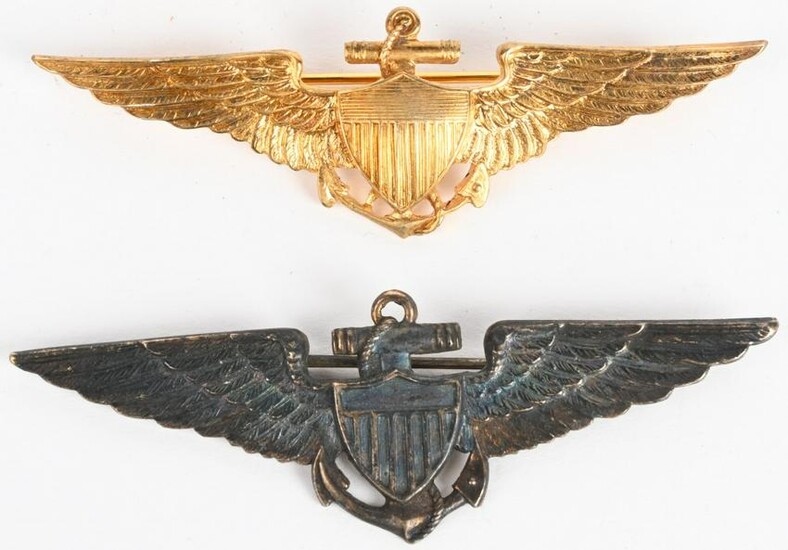1920's US NAVAL AVIATOR PILOT WINGS LOT OF 2
1920's US Navy Aviator Wings lot to include 1) Stamped brass wings with no berries measuring 3 inches wide with complete pin and catch assembly that are heavily patinated with a chocolate colored finish. 2) 3 Inch Naval Aviator Wing measuring 3 inches and are maker marked to NS Meyer and STERLING. still retains 100% of the original gilt. The 1920s was a decade of growth in naval aviation. The air arm steadily increased in size and strength while improving its administrative and operational position within the Navy. Small air detachments in each fleet proved effective during operations at sea. At the end of the decade three carriers sailed in full operation, patrol squadrons performed scouting functions, and commanders regularly assigned planes to battleships and cruisers. Impressive technical progress also characterized the decade. Despite slim funds for research, radial air-cooled engines developed into efficient and reliable sources of propulsion, better instruments came into use, and an accurate bombsight became available. Aircraft equipped with oleo struts and folding wings enhanced the operating capabilities of carriers. Each year planes flew faster, higher, and longer, and naval aviation contributed to world records. Sailors and Marines developed innovative tactics and learned techniques of dive bombing, torpedo attack, scouting, spotting for gunfire, and operating from advanced bases. Naval pilots used their skills to turn airplanes to new uses in polar exploration and photographic surveying, and solved the basic and unique problems of taking aviation to sea. Debates emerged in these years over the role of airpower and such issues as the role of the services in coastal defense included questions on the further need for a Navy. Naval aviators grew frustrated with their career limitations and lack of command responsibilities, and those within the aircraft industry became discontented with small peacetime orders, government procurement policies, and federal competition. Most of this was typical of new technology developing at a rapid pace, but some of these questions would persist for decades.
[ translate ]View it on
Sale price
Estimate
Time, Location
Auction House
1920's US Navy Aviator Wings lot to include 1) Stamped brass wings with no berries measuring 3 inches wide with complete pin and catch assembly that are heavily patinated with a chocolate colored finish. 2) 3 Inch Naval Aviator Wing measuring 3 inches and are maker marked to NS Meyer and STERLING. still retains 100% of the original gilt. The 1920s was a decade of growth in naval aviation. The air arm steadily increased in size and strength while improving its administrative and operational position within the Navy. Small air detachments in each fleet proved effective during operations at sea. At the end of the decade three carriers sailed in full operation, patrol squadrons performed scouting functions, and commanders regularly assigned planes to battleships and cruisers. Impressive technical progress also characterized the decade. Despite slim funds for research, radial air-cooled engines developed into efficient and reliable sources of propulsion, better instruments came into use, and an accurate bombsight became available. Aircraft equipped with oleo struts and folding wings enhanced the operating capabilities of carriers. Each year planes flew faster, higher, and longer, and naval aviation contributed to world records. Sailors and Marines developed innovative tactics and learned techniques of dive bombing, torpedo attack, scouting, spotting for gunfire, and operating from advanced bases. Naval pilots used their skills to turn airplanes to new uses in polar exploration and photographic surveying, and solved the basic and unique problems of taking aviation to sea. Debates emerged in these years over the role of airpower and such issues as the role of the services in coastal defense included questions on the further need for a Navy. Naval aviators grew frustrated with their career limitations and lack of command responsibilities, and those within the aircraft industry became discontented with small peacetime orders, government procurement policies, and federal competition. Most of this was typical of new technology developing at a rapid pace, but some of these questions would persist for decades.
[ translate ]


